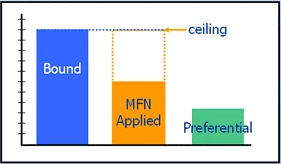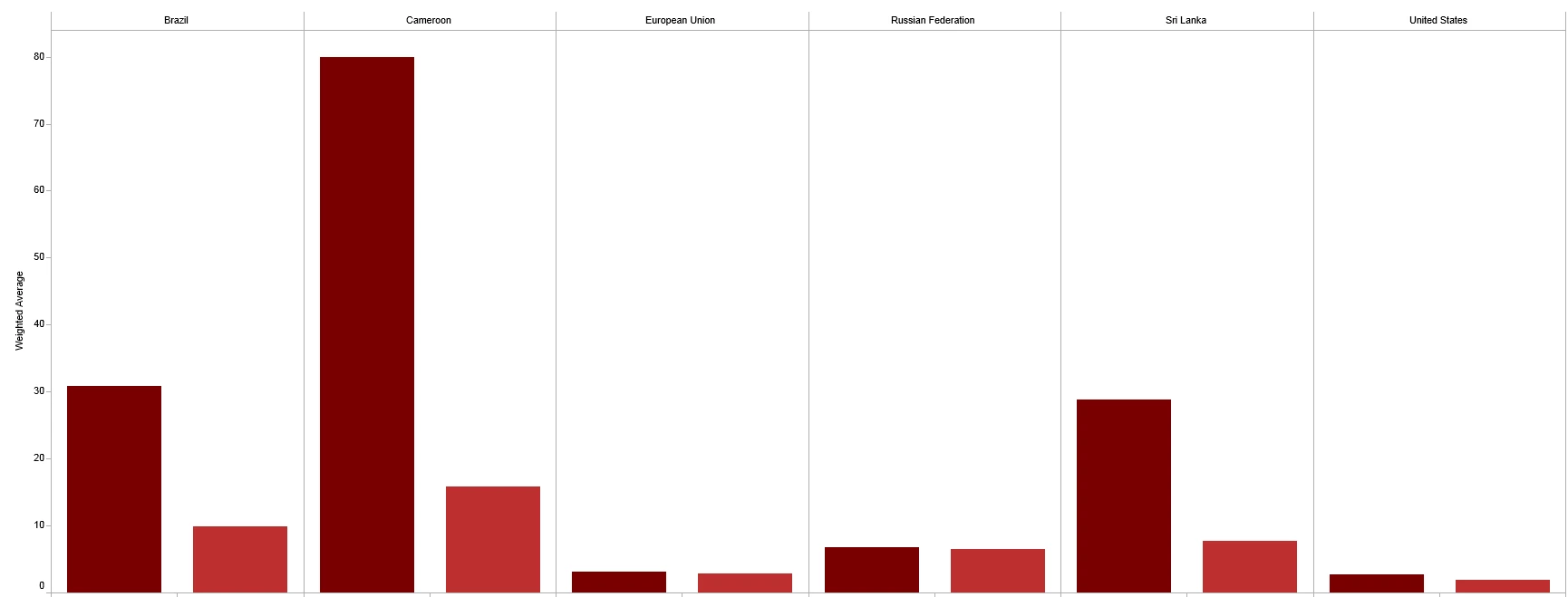Let’s start with the basics. What is a trade tariff? It’s a customs duty, or tax, on imported merchandise. For example, if a store owner is importing shoes, a tariff collected by her government might add to the price she has to pay for them. There has been a global effort to reduce tariffs around the world because they make goods more expensive for firms and consumers alike. Lowering tariffs was a major objective of the Uruguay round of negotiations at the World Trade Organization. But in certain circumstances, some governments consider tariffs helpful as a policy tool – they raise revenues and protect local industry from foreign competition (in the shoe example, a locally produced shoe might be cheaper than the imported one with a tariff).
While we’ve used a simple example, tariffs can be quite complex. There are three main types of tariff and they can be queried in UNCTAD TRAINS available through World Integrated Trade Solution (WITS). The three types of tariff are Most Favored Nation (MFN), Preferential and Bound Tariff.
A Most Favored Nation (MFN) Tariff is one that WTO member countries promise to impose all of their trading partners who are also WTO members, unless the country is part of a preferential trade agreement (such as a free trade area or customs union). This means that, in practice, MFN rates are the highest (most restrictive) tariffs that WTO members charge one another.
A Preferential Tariff is one that falls under a preferential trade agreement. Basically, countries make a deal in which they agree to charge a lower rate than the MFN rate. Details of various Preferential Tariffs are available in the Global Preferential Trade Agreement Database (GPTAD), which contains the original text of preferential trade agreements (PTA). It is indexed using classification consistent with WTO criteria.
In a customs union (such as the Southern Africa Customs Union or the European Community) or a free trade area (e.g., NAFTA), the preferential tariff rate is zero on almost all products. These agreements are reciprocal: all parties agree to give each other the benefits of lower tariffs. Some agreements specify that members will receive a percentage reduction from the MFN tariff, but not necessarily zero tariffs. Preferences therefore differ between partners and agreements.
Many countries, particularly the wealthier ones, give developing countries unilateral preferential treatment, rather than through a reciprocal agreement. The largest of these programs is the Generalized System of Preferences (GSP). The European Union, Japan, United States offer multiple unilateral preference programs. The EU's Everything But Arms (EBA) program is one example. Note exporting countries may have access to several different preference programs from a given importing partner and for a given product.
Bound Tariffs are specific commitments made by individual WTO member governments. The bound tariff is the maximum MFN tariff level for a given commodity line. When countries join the WTO or when WTO members negotiate tariff levels with each other during trade rounds, they make agreements about bound tariff rates, rather than actually applied rates.
Bound tariffs are not necessarily the rate that a WTO member applies in practice to other WTO members' products. Members have the flexibility increase or decrease their tariffs (on a non-discriminatory basis) so long as they didn't raise them above their bound levels. If one WTO member raises applied tariffs above their bound level, other WTO members can take the country to dispute settlement. If the country did not reduced applied tariffs below their bound levels, other countries could request “compensation” in the form of higher tariffs of their own. In other words, the applied tariff is less than or equal to the bound tariff in practice for any particular product.
The gap between the bound and applied MFN rates is called the "binding overhang." Trade economists argue that a large binding overhang makes a country's trade policies less predictable.

Compare Bind Overhang for Countries. Is your country’s bind overhand high or low?

So what tariff did our store owner pay for the shoe? This is called Effectively Applied Tariff and it is the lowest available tariff between MFN and various preferential tariff. If a preferential tariff exists, it will be used as the effectively applied tariff. Otherwise, the MFN applied tariff will be used.
How do you use these visualizations?

Use the “Types of tariff” visualization to see the difference between Bound, MFN and Effectively Applied Tariff. Which countries have a huge difference between the three? How does your country perform?
Use the MFN tariff and Effective applied tariff visualization to check MFN or effectively applied tariff for a country across years or comparing MFN/effectively applied tariff across countries.
Use the Bound tariff tab to see if a country’s bound tariff has reduced over time or if the country’s bound coverage has increased over time.
Use the bind overhang tab to check the difference between MFN rate and Bound rate for various countries. Do you think a huge overhang makes the countries trade policy less predictable? Check if your country of interest has a huge bound over hang. How many countries have 100% binding coverage?
You can interact with the visualization below or further explore different types of tariffs on the WITS site.
All the tariff shown in the visualization is for total trade, you can also register and login to WITS and perform your custom tariff analysis for individual products or groups. Explore other trade and tariff visualization in our data visualization page.
References:
MFN Weighted Average tariff of total trade by Country and Region
Effectively Applied Weighed Average tariff of total trade by Country and Region
Preferential Trade Agreement Database
Types of tariff help


Join the Conversation